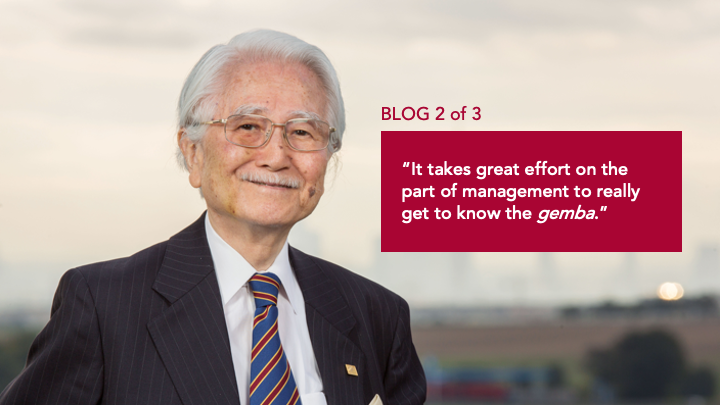During an exclusive interview with Masaaki Imai after his 90th birthday, he summarized his life-long learning on organizational behavior in three concepts. To pursue, achieve, and sustain greatness hinges on the commitment from top management, the focus of the whole organization on gemba (the actual place), and taking the customer seriously.
Top management
Masaaki Imai states categorically that an ongoing commitment from senior leadership to develop a system of excellence through the application of KAIZEN™ is the primary requirement to succeed. As described in the previous article, KAIZEN™ is all about a holistic approach to generate organization-wide transformation and it is not about disconnected, disjointed, and unsustainable short-term improvements. The simple wisdom stemming from his sixty-plus years of studying organizational behavior is that Continuous Improvement is really everyone, everywhere, every day improvement in an organization. He implies that improvement is not limited to project teams, frontline staff, or even frontline management. To achieve systemic improvement in an ongoing way requires a long-term commitment, especially from senior leaders. This is probably the lacking behavior for most organizations globally and the area where some of the biggest improvement opportunities can be identified.
Imai further mentions that a sense of superiority by management (at all levels) is foreign to the KAIZEN™ approach. The overemphasis of the achievement of the individual at the detriment of the group is often fueling this fire of inefficiency and ineffectiveness. Leaders and managers should be servant-leaders. They are not the “gods” to be adored; the real “gods” are the people at gemba. For some, this requires a huge paradigm shift.
Externally recruited leaders, or even leaders transferred or promoted internally, can be an obstacle in achieving excellence without the gemba orientation. Strategic direction and objectives often change with new leadership taking control, making the committed efforts and hard work from previous years, null and void. A lack of continuation, building on the past successes and learning from failures, can be detrimental to the medium and long-term health of a company.
Leaders without a profound knowledge of the system can bring about systemic changes without deeply understanding the impact on people, process, product, and ultimately, the customer. As the KAIZEN™ approach strongly emphasizes people development, KAIZEN™-minded companies coach their leaders to have an uncompromising gemba orientation to enable a sustainable improvement culture (The third blog of this series will explore Imai’s’ thoughts on some of the root causes of the leadership dilemma prevalent in many organizations across the globe).
During this interview, Imai said that it “takes great effort on the part of management to really get to know the gemba”. It is initially challenging, a sacrifice, as it requires a new set of behaviors. However, the KAIZEN™ methodology enables the development of these critical habits. Once these new habits have been standardized, KAIZEN™ becomes second nature.
Go to gemba
The focus on gemba is foundational to Imai’s teachings and the KAIZEN™ approach to organizational excellence. gembais the actual place, the real place, where the value-added work is done to satisfy the customer. It is the frontline or coalface where problems also persist if they are not clearly seen and solved. This requires practical, hands-on leadership by top management.
Imai’s observations since the 1950s of the key differences between traditional Western management and the KAIZEN™ management approach, is that KAIZEN™ leaders regard “going to gemba” as a critical part of managing processes and developing people. In too many organizations the coalface is avoided, almost at all cost, but ultimately at a huge cost.
Traditional leaders design strategy and targets in boardrooms and offices, pushing performance targets to gemba and expect the frontline to achieve these targets. From a KAIZEN™ perspective, this is seen as disrespecting people. Instead of a “command-and-control” management style, KAIZEN™ establishes “support-and-control”, enabling employees to manage their processes in pursuit of achieving their goals. This leadership style is not controlling employees but supporting them, serving and enabling people so they can control their processes. The wording seems subtle; the difference in practice is vast.
Showing respect to people is not just being nice, browsing in a factory with a grin. It is also more than management-by-walking-around. Respect is practical in the sense that leaders support frontline employees to see and solve the problems preventing them from achieving cascaded targets (as determined through the process of hoshin kanri).
The customer
The customer of our system (organization) and the “gift” or value we provide to them, is foundational in building an excellent and long-lasting organization. Imai says we should consider the customer’s viewpoints seriously. If we are to create customer value, we have to study the customer and their requirements, so we can design better products and services.
Continuously hearing the voice of the customer is done through standardized processes, showing commitment to the customer. This requires hard work, sacrifice, and discipline - a cornerstone of the house of gemba management (as Imai referred to it in his previous book). Studying the customer will lead to innovation: designing better products and processes, and marketing and selling more effectively. Therefore, innovation methods and process improvement methods coexist harmoniously in a KAIZEN™ Business System.
An organization exists because of the primary customer. Without the customer, there are no products, no system, no processes, no people, and no profits. KAIZEN™ organizations treat their customers’ voice with the utmost respect and this is reflected in all they do to implement management-led gemba practices.
Summary
Masaaki Imai condensed his learning during the last six decades about the hallmarks of excellent organizations in three concepts: top management commitment, gemba orientation, and customer focus. All three these concepts require a paradigm shift, the development of new organizational habits, indeed, a KAIZEN™ culture.
Topics in the next two blogs:
- Masaaki Imai and Taiichi Ohno.
- Meaningful reporting the KAIZEN™ way.
- Teasers from his third book.












